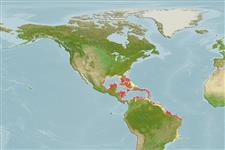Common names from other countries
Environment: milieu / climate zone / depth range / distribution range
Sinh thái học
Biển Cùng sống ở rạn san hô; Mức độ sâu 0 - 33 m (Ref. 57883). Tropical
Western Central Atlantic: Bermuda, USA and northern Cuba. Sympatric with Ogilbia sabaji and O. suarezae along the shores of Florida,
Bộ gần gũi / Khối lượng (Trọng lượng) / Age
Maturity: Lm ? range ? - ? cm
Max length : 6.0 cm SL con đực/không giới tính; (Ref. 57883)
Short description
Khóa để định loại | Hình thái học | Sinh trắc học
Các vây lưng mềm (tổng cộng) : 66 - 76; Tia mềm vây hậu môn: 50 - 57; Động vật có xương sống: 39 - 41. Diagnosis: The species is characterized by the following: Vertebrae 11-13 + 27-29 = 39-41, dorsal fin rays 66-76, anal fin rays 50-57; outer and inner pseudoclaspers simple, triangular flaps, outer about 2 times size of inner pseudoclasper; penis tapering; opercular spine
with single, sharp tip; scale patch on cheeks with 4-6 vertical scale rows; otolith length: height ratio 2.1-2.3, sulcus not inclined; ventral fin reaching about 2/3 from ventral fin base to anal fin base (15.3-23.9, x = 20.3 % SL); body slender (13.2-17.4, x = 15.4 % SL) (Ref. 57883).
The species prefers shallow algae habitats at depths from 0 to 8 m, except for a single record off North Carolina (USNM 223537) caught at a depth of 31-33 m. A 44 mm SL female specimen (ANSP 148378) contained 2 embryos (12 mm TL) and 15 eggs (diameter 0.3 mm). A 37 mm SL female (ANSP 148378) contains 3 embryos of 8 mm TL, 1 embryo of 4 mm SL, and 10 eggs, 0.5 mm in diameter. The embryos have black eyes, but no pigmentation on head and body,
probably due to bleaching (Ref. 57883). A cryptic species, locally abundant (Ref. 34024).
Life cycle and mating behavior
Maturities | Sự tái sinh sản | Spawnings | Egg(s) | Fecundities | Ấu trùng
Møller, P.R., W. Schwarzhans and J.G. Nielsen, 2005. Review of the American Dinematichthyini (Teleostei: Bythitidae). Part II. Ogilbia. aqua, J. Ichthyol. Aquat. Biol. 10(4):133-207. (Ref. 57883)
IUCN Red List Status (Ref. 130435)
CITES (Ref. 128078)
Not Evaluated
Threat to humans
Harmless
Human uses
Các nghề cá: không ích lợi (thú vị)
Các công cụ
Special reports
Download XML
Các nguồn internet
Estimates based on models
Preferred temperature (Ref.
115969): 24.9 - 28.2, mean 27.3 (based on 582 cells).
Phylogenetic diversity index (Ref.
82804): PD
50 = 0.5000 [Uniqueness, from 0.5 = low to 2.0 = high].
Bayesian length-weight: a=0.01000 (0.00244 - 0.04107), b=3.04 (2.81 - 3.27), in cm Total Length, based on all LWR estimates for this body shape (Ref.
93245).
Mức dinh dưỡng (Ref.
69278): 3.3 ±0.5 se; based on size and trophs of closest relatives
Thích nghi nhanh (Ref.
120179): thấp, thời gian nhân đôi của chủng quần tối thiểu là 4.5 - 14 năm (Assuming Fec < 100).
Fishing Vulnerability (Ref.
59153): Low vulnerability (10 of 100).
